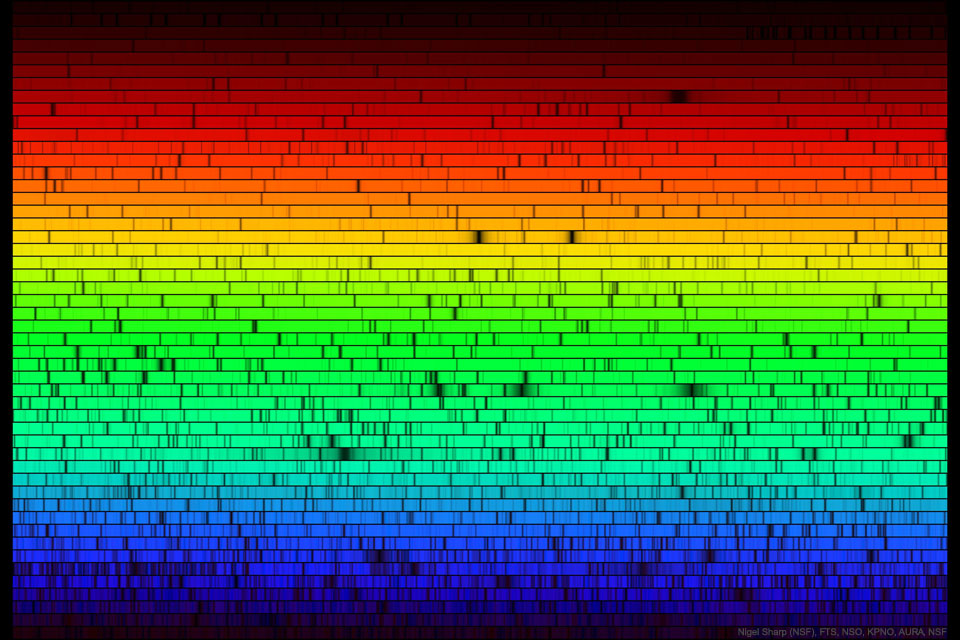11. June 2023
太陽 kah 伊 phàng-kìⁿ ê 色光

探索宇宙1!逐工會揀一幅無仝款 ê 影像抑是相片,𤆬你熟似咱這个迷人 ê 宇宙,閣有專業天文學者2為你3解說4。
- 原始文章:The Sun and Its Missing Colors
- 影像來源:Nigel Sharp (NSF), FTS, NSO, KPNO, AURA, NSF
- 台文翻譯:An-Li Tsai (NCU)
[漢羅] 太陽 kah 伊 phàng-kìⁿ ê 色光
遮有 太陽 所有 看會著 ê 色光,是日光迵過 像 稜鏡 這款家私 ê 時陣產生--ê。 這个 光譜 是 McMath-Pierce 太陽天文台 做--ê。 先講一下,咱 白色 ê 太陽 其實會發出 全部 ê 色光,毋過伊 tī 黃色 kah 青色 是 上光--ê。 這張光譜 內底一逝一逝較暗 ê 部份,是 太陽表面 抑是 頂懸 ê 氣體 吸收 下底 leh 發射 ê 日光。 無仝氣體會 吸收無仝色光,這會當幫贊咱了解太陽 ê 組成氣體是啥物。 舉一个例,日素 就是 1870 年 先 tī 太陽光譜內底揣著,後來 才 tī 地球 揣著 ê 元素。 今仔日咱已經有法度知影大部份 ê 光譜吸收線 是 ùi 佗一个元素來--ê,毋過 猶有一寡毋知。
[POJ] Thài-iâng kah i phàng-kìⁿ ê Sek-kng
Chia ū Thài-iông só͘-ū khòaⁿ-ē-tio̍h ê sek-kng, sī ji̍t-kng thàng-kòe chhiūⁿ lêng-kiàⁿ chit-khoán ke-si ê sî-chūn sán-seng--ê. Chit-ê kng-phó͘ sī McMath Pierce Thài-iông Thian-bûn-tâi chò--ê. Seng kóng chi̍t-ē, lán pe̍h-sek ê Thài-iông kî-si̍t ē hoat-chhut choân-pō͘ ê sek-kng, m̄-koh I tī n̂g-sek kah chheⁿ-sek sī siōng kng--ê. Chit-tiuⁿ kng-phó͘ lāi-té chi̍t-chōa chi̍t-chōa khah àm ê pō͘-hūn, sī Thài-iông piáu-bīn ia̍h-sī téng-koân ê khì-thé khip-siu ē-té leh hoat-siā ê ji̍t-kng. Bô-kâng khì-thé ē khip-siu bô-kâng sek-kng, che ē-tàng pang-chān lán liáu-kái Thài-iông ê cho͘-sêng khì-thé sī siáⁿ-mih. Kí chi̍t-ê lē, ji̍t sò͘ tio̍h-sī 1870 nî seng tī Thài-iông kng-phó͘ lāi-té chhē-tio̍h, āu-lâi chiah tī Tē-kiû chhōe-tio̍h ê goân-sò͘. Kin-á-ji̍t lán í-keng ū-hoat-tō͘ chai-iáⁿ tōa-pō͘-hūn ê kng-phó͘ khip-siu-sòaⁿ sī ùi tó-chi̍t-ê goân-sò͘ lâi--ê, m̄-koh iáu-ū chi̍t-kóa m̄-chai.
[KIP] Thài-iâng kah i phàng-kìnn ê Sik-kng
Tsia ū Thài-iông sóo-ū khuànn-ē-tio̍h ê sik-kng, sī ji̍t-kng thàng-kuè tshiūnn lîng-kiànn tsit-khuán ke-si ê sî-tsūn sán-sing--ê. Tsit-ê kng-phóo sī McMath Pierce Thài-iông Thian-bûn-tâi tsò--ê. Sing kóng tsi̍t-ē, lán pe̍h-sik ê Thài-iông kî-si̍t ē huat-tshut tsuân-pōo ê sik-kng, m̄-koh I tī n̂g-sik kah tshenn-sik sī siōng kng--ê. Tsit-tiunn kng-phóo lāi-té tsi̍t-tsuā tsi̍t-tsuā khah àm ê pōo-hūn, sī Thài-iông piáu-bīn ia̍h-sī tíng-kuân ê khì-thé khip-siu ē-té leh huat-siā ê ji̍t-kng. Bô-kâng khì-thé ē khip-siu bô-kâng sik-kng, tse ē-tàng pang-tsān lán liáu-kái Thài-iông ê tsoo-sîng khì-thé sī siánn-mih. Kí tsi̍t-ê lē, ji̍t sòo tio̍h-sī 1870 nî sing tī Thài-iông kng-phóo lāi-té tshē-tio̍h, āu-lâi tsiah tī Tē-kiû tshuē-tio̍h ê guân-sòo. Kin-á-ji̍t lán í-king ū-huat-tōo tsai-iánn tuā-pōo-hūn ê kng-phóo khip-siu-suànn sī uì tó-tsi̍t-ê guân-sòo lâi--ê, m̄-koh iáu-ū tsi̍t-kuá m̄-tsai.
[English] The Sun and Its Missing Colors
Here are all the visible colors of the Sun, produced by passing the Sun's light through a prism-like device. The spectrum was created at the McMath-Pierce Solar Observatory and shows, first off, that although our white-appearing Sun emits light of nearly every color, it appears brightest in yellow-green light. The dark patches in the featured spectrum arise from gas at or above the Sun's surface absorbing sunlight emitted below. Since different types of gas absorb different colors of light, it is possible to determine what gasses compose the Sun. Helium, for example, was first discovered in 1870 on a solar spectrum and only later found here on Earth. Today, the majority of spectral absorption lines have been identified - but not all.
詞彙學習
| 漢羅 | POJ | KIP | 華語 | English |
|---|---|---|---|---|
| 稜鏡 | lêng-kiàⁿ | lîng-kiànn | 稜鏡 | prism |
| 光譜 | kng-phó͘ | kng-phóo | 光譜 | spectrum |
| 日素 | ji̍t-sò͘ | ji̍t-sòo | 氦 | Helium |
| 吸收線 | khip-siu-sòaⁿ | khip-siu-suànn | 吸收線 | absorption lines |